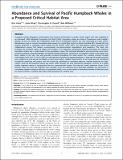Files in this item
Abundance and survival of Pacific humpback whales in a proposed critical habitat area
Item metadata
| dc.contributor.author | Ashe, Erin | |
| dc.contributor.author | Wray, Janie | |
| dc.contributor.author | Picard, Christopher R. | |
| dc.contributor.author | Williams, Robert | |
| dc.date.accessioned | 2013-09-16T08:31:01Z | |
| dc.date.available | 2013-09-16T08:31:01Z | |
| dc.date.issued | 2013-09-11 | |
| dc.identifier | 69971802 | |
| dc.identifier | 5e40311b-ba55-41cf-9a1d-b8e30d483f79 | |
| dc.identifier | 84907299902 | |
| dc.identifier.citation | Ashe , E , Wray , J , Picard , C R & Williams , R 2013 , ' Abundance and survival of Pacific humpback whales in a proposed critical habitat area ' , PLoS One , vol. 8 , no. 9 , e75228 . https://doi.org/10.1371/journal.pone.0075228 | en |
| dc.identifier.issn | 1932-6203 | |
| dc.identifier.uri | https://hdl.handle.net/10023/4054 | |
| dc.description | This research was funded through grants to Cetacealab and Gitga’at First Nation from Julie Walters and Sam Rose, and Fisheries and Oceans Canada (Cetacean Research Program, Species at Risk Program). The funders had no role in study design, data collection and analysis, decision to publish, or preparation of the manuscript. | en |
| dc.description.abstract | Humpback whales (Megaptera novaeangliae) were hunted commercially in Canada's Pacific region until 1966. Depleted to an estimated 1,400 individuals throughout the North Pacific, humpback whales are listed as Threatened under Canada's Species at Risk Act (SARA) and Endangered under the US Endangered Species Act. We conducted an 8-year photo-identification study to monitor humpback whale usage of a coastal fjord system in British Columbia (BC), Canada that was recently proposed as candidate critical habitat for the species under SARA. This participatory research program built collaborations among First Nations, environmental non-governmental organizations and academics. The study site, including the territorial waters of Gitga'at First Nation, is an important summertime feeding destination for migratory humpback whales, but is small relative to the population's range. We estimated abundance and survivorship using mark-recapture methods using photographs of naturally marked individuals. Abundance of humpback whales in the region was large, relative to the site's size, and generally increased throughout the study period. The resulting estimate of adult survivorship (0.979, 95% CI: 0.914, 0.995) is at the high end of previously reported estimates. A high rate of resights provides new evidence for inter-annual site fidelity to these local waters. Habitat characteristics of our study area are considered ecologically significant and unique, and this should be considered as regulatory agencies consider proposals for high-volume crude oil and liquefied natural gas tanker traffic through the area. Monitoring population recovery of a highly mobile, migratory species is daunting for low-cost, community-led science. Focusing on a small, important subset of the animals' range can make this challenge more tractable. Given low statistical power and high variability, our community is considering simpler ecological indicators of population health, such as the number of individuals harmed or killed each year by human activities, including ship strikes and entanglement in fishing gear. | |
| dc.format.extent | 1040541 | |
| dc.language.iso | eng | |
| dc.relation.ispartof | PLoS One | en |
| dc.subject | QL Zoology | en |
| dc.subject | SDG 3 - Good Health and Well-being | en |
| dc.subject.lcc | QL | en |
| dc.title | Abundance and survival of Pacific humpback whales in a proposed critical habitat area | en |
| dc.type | Journal article | en |
| dc.contributor.institution | University of St Andrews. School of Biology | en |
| dc.identifier.doi | 10.1371/journal.pone.0075228 | |
| dc.description.status | Peer reviewed | en |
This item appears in the following Collection(s)
Items in the St Andrews Research Repository are protected by copyright, with all rights reserved, unless otherwise indicated.

